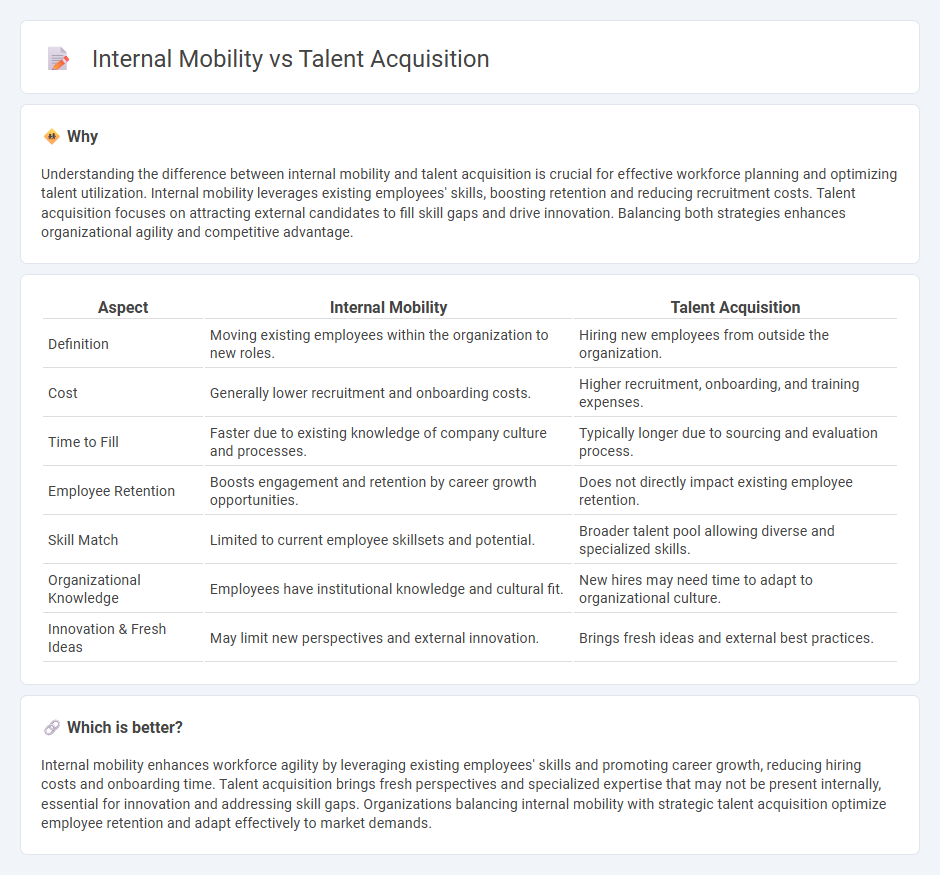
Internal mobility leverages existing employees' skills and institutional knowledge to fill open roles, reducing onboarding time and increasing retention rates. Talent acquisition focuses on sourcing external candidates to bring fresh perspectives and specialized expertise, often expanding the organization's talent pool. Explore how balancing these strategies can optimize workforce development and business growth.
Why it is important
Understanding the difference between internal mobility and talent acquisition is crucial for effective workforce planning and optimizing talent utilization. Internal mobility leverages existing employees' skills, boosting retention and reducing recruitment costs. Talent acquisition focuses on attracting external candidates to fill skill gaps and drive innovation. Balancing both strategies enhances organizational agility and competitive advantage.
Comparison Table
| Aspect | Internal Mobility | Talent Acquisition |
|---|---|---|
| Definition | Moving existing employees within the organization to new roles. | Hiring new employees from outside the organization. |
| Cost | Generally lower recruitment and onboarding costs. | Higher recruitment, onboarding, and training expenses. |
| Time to Fill | Faster due to existing knowledge of company culture and processes. | Typically longer due to sourcing and evaluation process. |
| Employee Retention | Boosts engagement and retention by career growth opportunities. | Does not directly impact existing employee retention. |
| Skill Match | Limited to current employee skillsets and potential. | Broader talent pool allowing diverse and specialized skills. |
| Organizational Knowledge | Employees have institutional knowledge and cultural fit. | New hires may need time to adapt to organizational culture. |
| Innovation & Fresh Ideas | May limit new perspectives and external innovation. | Brings fresh ideas and external best practices. |
Which is better?
Internal mobility enhances workforce agility by leveraging existing employees' skills and promoting career growth, reducing hiring costs and onboarding time. Talent acquisition brings fresh perspectives and specialized expertise that may not be present internally, essential for innovation and addressing skill gaps. Organizations balancing internal mobility with strategic talent acquisition optimize employee retention and adapt effectively to market demands.
Connection
Internal mobility enhances talent acquisition by leveraging existing employees' skills and potential, reducing recruitment costs and time-to-fill positions. Organizations that prioritize internal mobility create a dynamic talent pipeline, improving employee retention and engagement while aligning workforce capabilities with strategic goals. Integrating internal mobility strategies with talent acquisition processes enables companies to build a flexible, agile workforce ready to meet evolving business demands.
Key Terms
Recruitment
Talent acquisition focuses on sourcing and hiring external candidates to fill organizational roles, leveraging recruitment strategies like job postings, candidate sourcing, and employer branding. Internal mobility emphasizes promoting or transferring current employees within the company, enhancing retention and employee development while reducing hiring costs. Explore the differences and benefits of each approach to optimize your recruitment process.
Succession Planning
Talent acquisition targets external candidates to fill critical roles, leveraging market insights and diversity to drive succession planning. Internal mobility nurtures existing employees' growth, enhancing retention and aligning workforce capabilities with future leadership needs in succession pipelines. Explore strategic approaches to balance talent acquisition and internal mobility for robust succession planning.
Employee Retention
Talent acquisition targets external candidates to fill organizational roles, often bringing fresh skills and diverse perspectives that can enhance innovation. Internal mobility emphasizes promoting or transferring existing employees, leveraging their institutional knowledge and fostering career growth, which significantly boosts employee retention. Explore more strategies on balancing talent acquisition and internal mobility to maximize workforce stability and engagement.
Source and External Links
Talent Acquisition: The Ultimate Guide - AIHR - Talent acquisition is the process of identifying, attracting, selecting, and retaining highly qualified people using strategic approaches like "Build, Buy, Borrow, Bridge" to address organizational talent needs.
What is Talent Acquisition? Tips & FAQs - SmartRecruiters - Talent acquisition encompasses identifying, acquiring, assessing, and hiring skilled workers, while also focusing on employer branding, candidate lifecycle management, and employee retention.
What is talent acquisition? - Greenhouse - Talent acquisition is both a philosophy and a set of best practices that position people as key to organizational success, with strategies maturing from chaotic to systematic and, ultimately, strategic hiring.
 dowidth.com
dowidth.com